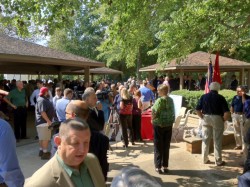Lawmakers and Officials From Two States Gather for Water Caucus Summit
That’s how Wednesday’s Joint State Savannah River Basin Caucus Summit at Big Oaks Recreation Center in Hartwell is being described by State Rep Alan Powell whose Georgia Savannah River Caucus hosted the event.
“This means a lot and to have this kind of influence of policy makers from two states should produce large benefits for this area,” Powell said.
State, federal and local leadership came together to discuss how better to manage the resources of the Savannah River Basin.
In a morning session, the crowd heard from Dr. Gene Eidson of the Institute of Computational Ecology at Clemson University.
Eidson’s group will be conducting a study of the Savannah River using a new data monitoring computer program called an Intelligent River Macroscope.
“We are able to aggragate all data, all public data will be aggragated into one accessible database,” Eidson said. “This really is a transformative way to collect data in order to move forward.”
Also speaking Wednesday was the Savannah River Keeper from Augusta, Tonya Bonatatibus, who said what happens to the river downstream is just as important as what happens upstream.
Bonatatibus noted the 400-mile long river is the 4th most toxic river in the U.S., which is why she said it’s important the water keeps flowing down stream, especially during times of drought.
“We dump 6.8 million gallons of affluent into this river every single year,” she said. “All of those pollution permits are based on, the solution to pollution is dilution. We have to be really careful during a drought. If the lake keeps all of that water, then what does Savannah drink? We have to dilute that waste.”
Bonitatibus said the only way to keep the water flowing is to keep the lines of communication open.
Local leaders also spoke on the economic importance of keeping the lake levels high – even during times of drought. Hart County Chamber Director Nikki Meyer said her community depends on tourism for its economic survival.
“The last tourism numbers in 2011 for Hart County contributed over $20-million in economic spending here,” she said. “That $20-million supported over 240 jobs. $830,000 in state taxes were collected. Over $600,000 in local sales tax were generated from tourism. Good water levels, lake events, and open lake access throughout the year are essential to our economy.”
Lavonia City Manager Gary Fesperman noted that when the lake level is low during a drought, water it provides its citizens is compromised.
“In our Gumlog Creek area, which sits directly across from Tugaloo State Park is where our intake valves are located,” Fesperman said. “Back when the lake went down 22-ft, our intake valves came within two feet of coming out of the water. Whenever the water goes down that low in the cove, it also gives us an incredible water quality issue, that provides a challenge to our water department operators in h ow to treat it, because you have an increase amount of manganese and iron in the water.”
Fesperman added local area businesses thrive on lake dollars.

